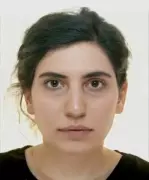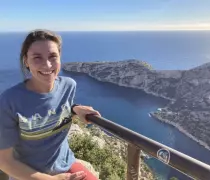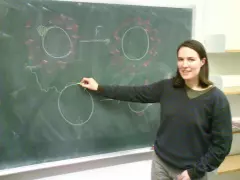 03/12/2025, 16:00 — 17:00 — Online
03/12/2025, 16:00 — 17:00 — Online
Josué Corujo Rodríguez, Faculté de Sciences et Technologies of the Université Paris-Est Créteil
Functional CLT for the Erdős–Rényi giant component
We study the fluctuations of the size (that is, the number of vertices) of the giant component in the Erdős–Rényi random graph process. The functional CLT in the supercritical case was recently obtained by Enriquez, Faraud and Lemaire. Our approach is based on an exploration algorithm called the simultaneous breadth-first walk, introduced by Limic in 2019, which encodes the dynamics of the evolution of the sizes of the connected components of random graph processes. We will also discuss how our method can be adapted to establish a similar functional CLT in the barely supercritical regime.
This is joint work with Vlada Limic and Sophie Lemaire.
 26/11/2025, 16:00 — 17:00 — Online
26/11/2025, 16:00 — 17:00 — Online
Saraí Hernández-Torres,, Instituto de Matemáticas
Three-dimensional loop-erased random walks
The loop-erased random walk (LERW) is a fundamental model for random self-avoiding curves. Since its introduction by Lawler in the 1980s, the scaling limits of LERW have been thoroughly studied. While these limits are well-understood in dimensions two, four, and higher, the three-dimensional case continues to present unique challenges.
19/11/2025, 16:00 — 17:00 — Online
Victor Rivero, Centro de Investigación en Matemáticas
Stability of (sub)critical non-local spatial branching processes with and without immigration
In this talk, I will present some recent results for general non-local branching particle process or general non-local superprocess, in both cases, with and without immigration. Under the assumption that the mean semigroup has a Perron-Frobenious type behaviour, for the immigrated mass, as well as the existence of second moments, we consider necessary and sufficient conditions that ensure limiting distributional stability. More precisely, our first main contribution pertains to proving the asymptotic Kolmogorov survival probability and Yaglom limit for critical non-local branching particle systems and superprocesses under a second moment assumption on the offspring distribution. Our results improve on existing literature by removing the requirement of bounded offspring in the particle setting and to include non-local branching mechanisms. Our second main contribution pertains to the stability of both critical and sub-critical non-local branching particle systems and superprocesses with immigration. At criticality, we show that the scaled process converges to a Gamma distribution under a necessary and sufficient integral test. At subcriticality we show stability of the process, also subject to an integral test. In these cases, our results complement classical results for (continuous-time) Galton-Watson processes with immigration and continuous-state branching processes with immigration.
 12/11/2025, 16:00 — 17:00 — Online
12/11/2025, 16:00 — 17:00 — Online
Orphée Collin, TU Wien
The random field Ising chain in the large interaction limit
We are going to present recent results and ongoing research concerning the Ising chain (i.e., the Ising model in dimension 1) with homogeneous (large) spin-spin interaction, but subjected to a random external field, the latter being sampled from an i.i.d sequence. The framework is that of disordered systems. We will first present the pure model (homogeneous external field) which is exactly solvable. Then we will turn to the disordered model, showing that for this model the disorder is strongly relevant, through estimates on the free energy and a description of the typical configurations. There are two distinct cases with qualitatively different behaviours: the cases of centered or uncentered disorder. We will also present a continous analogue of the model, obtained by a weak disorder limit, which has the advantage of allowing some explicit computations. Our approach confirms and deepens claims made in the physics literature by D. Fisher and collaborators, based on a study of the Glauber dynamics of the model using the renormalisation group method.
 05/11/2025, 16:00 — 17:00 — Online
05/11/2025, 16:00 — 17:00 — Online
Anastasiia Trofimova, Gran Sasso Science Institute
Scaling properties of current fluctuations in periodic TASEP
The Totally Asymmetric Simple Exclusion Process (TASEP) on a ring of size $ N $ with $ p $ particles is a key model in non-equilibrium statistical physics. While its stationary state is well understood, the relaxation dynamics and current fluctuations in finite systems are less explored. We introduce a deformation parameter $ \gamma $ defining a tilted operator controlling the time-integrated current statistics. Using the coordinate Bethe ansatz, we obtain implicit formulas for the scaled cumulant generating function (SCGF) and spectral gap, expressed via Bethe roots and characterized asymptotically by the Cassini oval geometry.
In the thermodynamic limit with fixed particle density, a dynamical phase transition emerges between fluctuation regimes: for $ \gamma > 0 $, the SCGF scales ballistically with system size, $ \lambda_1 \sim N $, and the spectral gap closes polynomially, $ \Delta \sim N^{-1} $, indicating rapid relaxation. For $ \gamma < 0 $, the SCGF converges to $-1$, with an exponentially closing gap, $ \Delta \sim \exp(-cN) $, signaling metastability. These non-perturbative results provide new insights into large deviations and relaxation dynamics in driven particle systems.
 22/10/2025, 17:00 — 18:00 — Online
22/10/2025, 17:00 — 18:00 — Online
Sayeh Khaniha, Universidade de São Paulo
Hierarchical Clustering Algorithms on Poisson and Cox Point Processes
Clustering is a widely used technique in unsupervised learning for identifying groups within a dataset based on similarities among its elements. In this talk, I will introduce a novel hierarchical clustering model specifically designed for datasets with a countably infinite number of points. The proposed algorithm constructs clusters at successive levels using nearest-neighbor chains of points or clusters. We apply this algorithm to the Poisson point process and show that it defines a phylogenetic forest that is a factor of the process and, consequently, unimodular. We then study various properties of this random forest, including the mean cluster size at each level and the mean size of the cluster containing a typical node.
 15/10/2025, 17:00 — 18:00 — Online
15/10/2025, 17:00 — 18:00 — Online
José Luis Pérez Garmendia, Centro de Investigación en Matemáticas, México
Fluctuation theory for spectrally negative Lévy processes killed by an additive functional and applications to the penalization problem
In this talk we solve the exit problems for spectrally negative Lévy processes, which are exponentially killed with a killing intensity dependent on an additive functional of the Lévy process. Additionally, we study their associated resolvents. All identities are given in terms of new generalizations of scale functions. Our results generalize those for omega-killed spectrally negative processes obtained by Palmowski and Li. Finally, we apply these results to derive penalization results for spectrally negative Lévy processes with clocks driven by additive functionals. This is joint work with Kei Noba, Kouji Yano, and Kohki Ibba.
 01/10/2025, 17:00 — 18:00 — Online
01/10/2025, 17:00 — 18:00 — Online
Katharina Schuh, Technische Universität Wien
Long-time analysis of second-order Langevin diffusions with distribution-dependent forces and their numerical discretizations
In this talk, we explore the long-time behaviour of both the classical second-order Langevin diffusion and a non-linear variant with distribution-dependent forces of McKean-Vlasov type. In addition, we study a class of kinetic Langevin sampler – numerical discretization schemes for these continuous dynamics – and investigate their asymptotic behaviour.
We establish $L^1$ Wasserstein contraction for both the continuous dynamics and its numerical approximations using couplings and provide qualitative error bounds for the proposed numerical schemes. In our analysis, we consider not only strongly convex confining potentials but also multi-well potentials and non-gradient-type external forces as well as non-gradient-type interaction forces that can be attractive or repulsive.
For the non-linear variant, we exploit the connection to the corresponding particle system and we present a uniform in-time propagation of chaos result in $L^1$ Wasserstein distance.
 02/07/2025, 17:00 — 18:00 — Online
02/07/2025, 17:00 — 18:00 — Online
Havva Yoldaş, Delft Institute of Applied Mathematics, TU Delft
Quantitative hypocoercivity results for kinetic equations in mathematical biology
After a short introduction on kinetic equations and classical $L^2/H^1$ hypocoercivity techniques due to Dolbeault, Mouhot, Schmeiser AMS 2015, I will talk about Harris-type theorems that is an alternative method for obtaining quantitative convergence rates. I will discuss how to use these theorems summarising some recent results obtained jointly with Jo Evans (Warwick) on the run and tumble equations that is a kinetic-transport equation modelling the bacterial movement under the effect of a chemoattractant.
 25/06/2025, 17:00 — 18:00 — Online
25/06/2025, 17:00 — 18:00 — Online
Minmin Wang, University of Sussex
Exchangeability in continuum random trees
De Fenetti’s Theorem states that all N-indexed exchangeable sequences of real-valued random variables are mixings of i.i.d sequences. For real-valued random processes with exchangeable increments on [0, 1], Kallenberg’s 1973 result provides a complete characterisation of these processes via another mixing relationship. Continuum random trees are random tree-like metric spaces that arise naturally as scaling limits of various models of discrete random trees. In this talk, we will focus in particular on two subclasses of continuum random trees: the so-called stable trees and inhomogeneous continuum random trees. An analogue of Kallenberg’s Theorem for continuum random trees first appeared as a claim in a 2004 paper by Aldous, Miermont and Pitman. They suggested that, in much the same way that a stable bridge process on [0, 1] is a mixing of certain extremal exchangeable processes, stable trees are mixings of inhomogeneous continuum random trees. We present an outline of a rigorous argument supporting this claim, based on a novel construction that applies to both classes of trees. We will also briefly discuss some implications of this result on critical random graphs.
 04/06/2025, 17:00 — 18:00 — Online
04/06/2025, 17:00 — 18:00 — Online
Jani Lukkarinen, University of Helsinki
Generation of chaos in the cumulant hierarchy of the stochastic Kac model
Propagation and generation of chaos is an important ingredient for rigorous control of applicability of kinetic theory, in general. Chaos is here understood as sufficient statistical independence of random variables related to the "kinetic" observables of the system. Cumulant hierarchy of these random variables thus often gives a way of controlling the evolution and degree of such independence, i.e., the degree of chaos in the system. In this talk, I will discuss our analysis of the cumulant hierarchy of the stochastic Kac model in the preprint [arxiv.org:2407.17068], a joint work with Aleksis Vuoksenmaa. We control generation of chaos via the magnitude of finite order cumulants of kinetic energies for arbitrary symmetric initial data, with the usual restriction of a fixed energy density. This allows estimating the accuracy of kinetic theory, uniformly in time and for any system with sufficiently large number of particles, N. We prove that the evolution of the system can be divided into three regimes: an initial regime of the length of at most O(ln N) in which the state of the system becomes chaotic, the kinetic regime which is determined by solutions to the Boltzmann-Kac equation, and an equilibrium regime.
 28/05/2025, 17:00 — 18:00 — Online
28/05/2025, 17:00 — 18:00 — Online
Alexander Drewitz, Universität zu Köln
(Near-)critical behavior of a strongly correlated percolation model
For (near-)critical independent Bernoulli percolaAlexander Drewitztion, particularly profound results have been obtained in the high-dimensional setting as well as on planar lattices. We consider a strongly correlated percolation model — the level sets of the metric graph Gaussian free field — where significant understanding has also been developed regarding its (near-)critical behavior in intermediate dimensions. We will explain the origin of the model's integrability, and discuss its implications for the associated universality class. A particular focus will be on recent results for the critical exponents associated to the volume of critical connected components.
 14/05/2025, 17:00 — 18:00 — Online
14/05/2025, 17:00 — 18:00 — Online
Scott Armstrong, CNRS Directeur de recherche at Sorbonne University and Courant Institute of Mathematical Sciences at NYU
Superdiffusivity for a diffusion in a critically-correlated incompressible random drift
We consider a Brownian particle in a divergence-free drift, where the vector field is a stationary random field exhibiting "critical" correlations. Predictions from physicists in the 80s state that, almost surely, this process should behave like a "sped-up" Brownian motion at large scales, with variance at time ~$t$ being of order ~$t \sqrt{\log t}$. In joint work with Ahmed Bou-Rabee and Tuomo Kuusi, we give a rigorous proof of this prediction using an iterative quantitative homogenization procedure, which is a way of formalizing a renormalization group argument. We consider the generator of the process and coarse-grain this operator, scale-by-scale, across an infinite number of scales. The random swirls of the vector field at each scale enhance the effective diffusivity. As we zoom out, we obtain an ODE for the effective diffusivity as a function of the scale, to deduce that it diverges at the predicted rate. Meanwhile, new coarse-graining arguments allow us to rigorously (and quenchedly) integrate out the smaller scales and prove the scaling limit.
 07/05/2025, 17:00 — 18:00 — Online
07/05/2025, 17:00 — 18:00 — Online
Chiara Amorino, Universitat Pompeu Fabra, Barcelona
Nonparametric estimation of McKean-Vlasov SDEs via deconvolution
We investigate the estimation of the interaction function for a class of McKean-Vlasov stochastic differential equations. The estimation is based on observations of the associated particle system at time $T$, considering the scenario where both the time horizon $T$ and the number of particles $N$ tend to infinity. Our proposed method recovers polynomial rates of convergence for the resulting estimator. This is achieved under the assumption of exponentially decaying tails for the interaction function. Additionally, we conduct a thorough analysis of the transform of the associated invariant density as a complex function, providing essential insights for our main results.
 30/04/2025, 17:00 — 18:00 — Online
30/04/2025, 17:00 — 18:00 — Online
Charles Bordenave, CNRS researcher at the Institut de Mathématiques de Marseille, France
Cutoff for geodesic paths on hyperbolic manifolds
This is based on a joint work with Joffrey Mathien. We establish new instances of the cutoff phenomenon for geodesic paths and for the Brownian motion on compact hyperbolic manifolds. We prove that for any fixed compact hyperbolic manifold, the geodesic path started on a spatially localized initial condition exhibits cutoff. Our work also extends results obtained by Golubev and Kamber on hyperbolic surfaces of large volume to any dimension. More generally, we will discuss ongoing works on the cutoff phenomenon in mixing dynamical systems.
 23/04/2025, 17:00 — 18:00 — Online
23/04/2025, 17:00 — 18:00 — Online
Benoit Dagallier, CEREMADE, Universite Paris Dauphine-PSL, France
Uniqueness of the invariant measure of the phi42 dynamics in infinite volume
I will discuss the phi42 dynamics, a singular stochastic partial differential formally corresponding to the Langevin dynamics for the phi42 field theory model. The goal is to characterise infinite volume invariant measures for these dynamics. The associated phi42 theory is known to undergo phase transitions as parameters in the model are varied, with the field transitioning from short-distance correlations (in the sense that the susceptibility of the measure defined on a finite box is bounded uniformly on the box size) to long-distance correlations. One expects this behaviour to be reflected in the dynamics, with a unique infinite volume invariant measure in absence of phase transition and possibly more than one in the strongly correlated regime. We prove that this picture is indeed correct in the sense that there is a unique invariant measure for the dynamics whenever the susceptibility is finite. This is done by adapting to the field-theory setting the Holley-Stroock-Zegarlinski approach to uniqueness for statistical mechanics models. This approach is based on a volume-independent bound on the log-Sobolev constant of the associated dynamics, together with crude, model-independent bounds. In the phi42 case the log-Sobolev has recently been established, but substantial work is required to adapt the other parts of the argument. The talk is based on joint work in progress with R. Bauerschmidt and H. Weber.
 16/04/2025, 17:00 — 18:00 — Online
16/04/2025, 17:00 — 18:00 — Online
Alejandro Rosales Ortiz, Universität Zürich, Switzerland
Excursion theory for Markov processes indexed by Lévy trees
We begin by introducing Markov processes indexed by Lévy trees, a notion which was developed in a series of works by Duquesne, Le Gall and Le Jan, and that has seen multiple applications in recent years. We will then present the main aspects of a theory, developed in two recent works with Armand Riera, that describes the evolution of a Markov process indexed by a Lévy tree between visits to a regular, instantaneous point of the state space. Despite the radically different setting, we will see that our results share strong similarities with the celebrated Itô excursion theory for Brownian motion. An excursion theory for Brownian motion indexed by the Brownian tree was previously developed by Le Gall and Abraham [JEMS;18], and in particular we recover their results by different methods. Our work is motivated by applications in random geometry.
 09/04/2025, 17:00 — 18:00 — Online
09/04/2025, 17:00 — 18:00 — Online
Louis Fan, University of North Carolina, USA
Conditional coalescent given the random pedigree
In theoretical population genetics, it is customary to describe gene genealogies by averaging over the pedigree (the global graph of reproductive relationships). This assumption is built into state-of-the-art statistical tools, classical work on the Kingman coalescent, and related work on multiple mergers. However, this tradition of averaging over the pedigree is questionable because there is only one population pedigree, and all genetic information is passed through this same pedigree. Here we study how the pedigree influences the genealogical relationships of a sample of gene copies at a single genetic locus. We perform this study through the lens of two different diploid exchangeable models: a Wright-Fisher model with occasional big families and a Moran model with partial selfing. For each model, we obtain a novel scaling limit for the conditional genealogy of an arbitrary sample of size n, as the population size N tends to infinity. These scaling limits retain essential information of the population pedigree. Our results offer new insight for ancestral inference and understanding of multi-locus data from populations whose single-locus genealogies are multiple merger coalescents. Joint work with F. Alberti, M. Birkner, D. Diamantidis, M. Newman, and J. Wakeley.
 02/04/2025, 17:00 — 18:00 — Online
02/04/2025, 17:00 — 18:00 — Online
Guido Mazzuca, Tulane University, USA
Generalized Hydrodynamics for the Volterra lattice
While the mathematical foundations of Generalized Hydrodynamics (GHD) are still incomplete, the theory has proven to be a powerful tool for obtaining accurate approximations of correlation functions in various integrable models. Notably, H. Spohn applied GHD to compute the correlation function of the Toda lattice. In this talk, we focus on the Volterra lattice, another integrable system. We introduce its Generalized Gibbs Ensemble (GGE) and establish a connection with the Anti-symmetric β-ensemble, a well-known random matrix model. This link enables us to explicitly determine the density of states for the Volterra lattice in terms of the corresponding quantity in the random matrix model. Using this result, we apply GHD to derive a linear approximation of the correlation function for the Volterra lattice. This talk is based on the following paper: G. M., Generalized Hydrodynamics for the Volterra Lattice: Ballistic and Nonballistic Behavior of Correlation Functions. J. Phys. A: Math. Theor. DOI: 10.1088/1751-8121/ad742b
 26/03/2025, 16:00 — 17:00 — Online
26/03/2025, 16:00 — 17:00 — Online
Amanda Turner, University of Leeds
Local fluctuations for planar aggregation
Planar random growth processes occur widely in the physical world. Examples include diffusion-limited aggregation (DLA) for mineral deposition and the Eden model for biological cell growth. One approach to mathematically modelling such processes is to represent the randomly growing clusters as compositions of conformal mappings. In 1998, Hastings and Levitov proposed one such family of models, which includes versions of the physical processes described above. An intriguing property of their model is a conjectured phase transition between models that converge to growing disks, and 'turbulent' non-disk like models. In previous work with Norris and Silvestri, we have shown that the global fluctuations present in these models exhibit behaviour that can be interpreted as the beginnings of a macroscopic phase transition from disks to non-disks. In this talk I will discuss work in progress with Larissa Richards in which we explore how the correlation structure of local fluctuations near the cluster boundary changes at the point of phase transition.
